Standards Worldwide
Standards Worldwide
Phone +49 30 58885700-07

Standard [CURRENT]
ASTM F 3478:2020
Standard Practice for Development of a Durability and Reliability Flight Demonstration Program for Low-Risk Unmanned Aircraft Systems (UAS) under FAA Oversight
- Publication date
- 2020
- Original language
- English
- Pages
- 22
- Publication date
- 2020
- Original language
- English
- Pages
- 22
- DOI
- https://dx.doi.org/10.1520/F3478-20
Product information on this site:
Quick delivery via download or delivery service
Buy securely with a credit card or pay upon receipt of invoice
All transactions are encrypted
Short description
1.1 This standard practice is intended for low-risk UAS seeking type certification by the Federal Aviation Administration (FAA) under 14 CFR Part 21.17(b) in accordance with the FAA durability and reliability (D&R) means of compliance (MOC). The definition of "low-risk UAS" does not necessarily align with other definitions found within corresponding ASTM standards ( F3442/F3442M ) or other UAS-related standards. For the purposes of this practice, "low-risk" is defined as a UAS operated in accordance with the concept of operations (CONOPs), eligibility criteria, and kinetic energy threshold specified in the G-1 Issue Paper (which will be provided to the applicant by the FAA). See 4.3 for design criteria and operating limitations for low-risk UAS. 1.2 This standard practice establishes a common methodology and key considerations for the development of minimum flight plans for low-risk UAS that demonstrate aircraft reliability as part of a D&R MOC. 1.3 The scope of this standard practice encompasses D&R planning, data collection, and reporting. 1.4 The values stated in SI units are to be regarded as standard. This is not intended to limit the systems of units used for design, development testing, or demonstration testing. However, the units of measurement used on pilot-facing placards and markings and manuals must be the same as those used on the corresponding equipment with recognition that international aviation utilizes feet for altitude and knots for airspeed as operational parameters. 1.5 This standard does not purport to address all of the safety concerns, if any, associated with its use. It is the responsibility of the user of this standard to establish appropriate safety, health, and environmental practices and determine the applicability of regulatory limitations prior to use. 1.6 This international standard was developed in accordance with internationally recognized principles on standardization established in the Decision on Principles for the Development of International Standards, Guides and Recommendations issued by the World Trade Organization Technical Barriers to Trade (TBT) Committee.
ICS
03.220.50,
49.020
DOI
https://dx.doi.org/10.1520/F3478-20
Loading recommended items...
Loading recommended items...
Loading recommended items...
